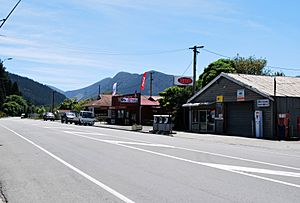Rai Valley facts for kids
Quick facts for kids
Rai Valley
|
|
|---|---|
 |
|
| Country | New Zealand |
| District | Marlborough |
| Ward |
|
| Electorates |
|
| Area | |
| • Total | 27.96 km2 (10.80 sq mi) |
| Population
(June 2023)
|
|
| • Total | 190 |
| • Density | 6.80/km2 (17.6/sq mi) |
Rai Valley is a small, quiet community in Marlborough, New Zealand. It's found on State Highway 6. It's about 68 kilometers (42 miles) northwest of Blenheim. It's also about 46 kilometers (29 miles) east of Nelson.
The Rai River flows through the area. It joins the Pelorus River near Pelorus Bridge further south. In 2018, about 177 people lived here. The name Rai Valley might come from a Rangitāne chief named Rai kau moana.
The area is known for dairy farming. A factory for dairy products and cheese was built here around 1909.
Rai Valley's Past
The Rai Valley was one of the last places in northern Marlborough that Europeans explored. John Tinline found the valley in January 1850. He was looking for a new way to get to Nelson.
In the 1800s, the Rai Valley was covered in thick forests. A small town called Carluke grew up near the Rai Valley community. This happened around a sawmill built by William Brownlee in 1907. About 100 people worked at this mill. A small railway line connected the mill to a port on the Pelorus River.
After World War I, in 1919, many soldiers who returned home started farms in the area.
Who Lives in Rai Valley?
Rai Valley is a rural settlement, meaning it's a small community in the countryside. It covers about 27.96 square kilometers (10.8 square miles). As of 2018, the estimated population was 177 people. This means there are about 6.3 people living per square kilometer. Rai Valley is part of a larger area called Marlborough Sounds West.
The population of Rai Valley has grown over the years:
- In 2006, there were 141 people.
- In 2013, there were 147 people.
- In 2018, there were 177 people.
This shows an increase of 30 people (20.4%) from 2013 to 2018.
In 2018, there were 81 households in Rai Valley. There were 84 males and 96 females. The average age was 40.8 years old. About 25.4% of the people were under 15 years old.
Most people in Rai Valley are of European/Pākehā background (93.2%). Some people are Māori (20.3%) or Pasifika (3.4%).
When asked about religion, most people (67.8%) said they had no religion. About 20.3% were Christian.
Learning in Rai Valley
Rai Valley has its own school called Rai Valley Area School. This school teaches students from year 1 all the way up to year 13. It is a coeducational school, meaning both boys and girls attend. The school has about 94 students.
Rai Valley's Weather
| Climate data for Rai Valley (1981–2010 normals, extremes 1962–1987) | |||||||||||||
|---|---|---|---|---|---|---|---|---|---|---|---|---|---|
| Month | Jan | Feb | Mar | Apr | May | Jun | Jul | Aug | Sep | Oct | Nov | Dec | Year |
| Record high °C (°F) | 31.5 (88.7) |
33.6 (92.5) |
30.0 (86.0) |
25.7 (78.3) |
21.8 (71.2) |
19.2 (66.6) |
19.6 (67.3) |
18.8 (65.8) |
24.0 (75.2) |
25.3 (77.5) |
27.6 (81.7) |
28.7 (83.7) |
33.6 (92.5) |
| Mean daily maximum °C (°F) | 22.5 (72.5) |
23.2 (73.8) |
21.2 (70.2) |
18.2 (64.8) |
15.6 (60.1) |
12.7 (54.9) |
12.4 (54.3) |
13.8 (56.8) |
15.6 (60.1) |
17.1 (62.8) |
18.8 (65.8) |
20.7 (69.3) |
17.7 (63.8) |
| Daily mean °C (°F) | 16.7 (62.1) |
16.8 (62.2) |
15.6 (60.1) |
12.5 (54.5) |
10.1 (50.2) |
7.6 (45.7) |
6.8 (44.2) |
8.1 (46.6) |
10.2 (50.4) |
12.0 (53.6) |
13.4 (56.1) |
15.7 (60.3) |
12.1 (53.8) |
| Mean daily minimum °C (°F) | 10.9 (51.6) |
10.4 (50.7) |
9.9 (49.8) |
6.8 (44.2) |
4.6 (40.3) |
2.5 (36.5) |
1.2 (34.2) |
2.4 (36.3) |
4.8 (40.6) |
6.8 (44.2) |
8.0 (46.4) |
10.6 (51.1) |
6.6 (43.8) |
| Record low °C (°F) | 1.3 (34.3) |
0.7 (33.3) |
−3.0 (26.6) |
−4.1 (24.6) |
−6.9 (19.6) |
−7.6 (18.3) |
−7.8 (18.0) |
−6.6 (20.1) |
−5.2 (22.6) |
−4.4 (24.1) |
−2.0 (28.4) |
−0.7 (30.7) |
−7.8 (18.0) |
| Average rainfall mm (inches) | 140.8 (5.54) |
113.7 (4.48) |
152.1 (5.99) |
197.5 (7.78) |
193.8 (7.63) |
171.3 (6.74) |
176.5 (6.95) |
162.4 (6.39) |
141.0 (5.55) |
223.4 (8.80) |
164.2 (6.46) |
180.6 (7.11) |
2,017.3 (79.42) |
| Source: NIWA (rain 1971–2000) | |||||||||||||

